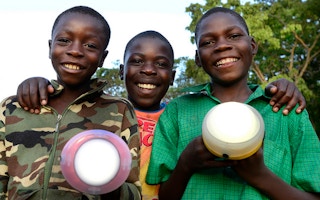With 600 million people in Africa still without electricity and relying on expensive kerosene for lighting, the invention of a new high-quality solar light gives hope for a better quality of life for the poorest people of the continent.
And with solar light design and quality constantly improving and prices falling, a brighter future is more affordable – and can even turn a profit for householders.
The new £4 ($5) lamp now on offer in parts of East Africa was created by Inventid, a company based in Manchester, UK, and has undergone trials with 9,000 families in Malawi, Uganda and Zambia. The SM100, as it is called, is now being made in China by the solar giant Yingli and distributed in Africa by the charity SolarAid.
The lamp is small enough to be used as a hand torch or a bicycle lamp, and has a stand which lets it be used as a table lamp or overhead light. It is tough enough to survive being dropped, or drenched in rain.
SolarAid, which has been pioneering the sale of solar lamps to poor communities in Africa since 2006, says the new model gives twice the light of a kerosene lamp and and, over its five-year guaranteed lifetime, saves a ton of carbon dioxide for each kerosene light it replaces.
“
We know that much of the money saved is spent on food and seeds. This is a great way to help people help themselves while famine stalks the continent.
Jeremy Leggett, founding director, SolarAid
Cash generator
Although it is a charity, rather than give the lamps away SolarAid prefers to sell them at cost, creating trade in the economy.
“Each lamp sold at £4 generates £145 in cash for food and essentials in East Africa,” it says.
Jeremy Leggett, founding director of SolarAid, says there are not many social-benefit paybacks as good as this in the world today: “We know that much of the money saved is spent on food and seeds. This is a great way to help people help themselves while famine stalks the continent.”
Most people without electricity in Africa live on less than $1 a day, and buying kerosene takes up around 15 per cent of their annual income.
The SM100 runs at full power for up to eight hours when fully charged, and will also charge mobile phones. As well as helping people escape from poverty, the lamps also help to improve their health; kerosene fumes damage eyes and lungs. The light also allows children to study after dark.
But Leggett says it is the light itself that makes the real difference. “Seeing the faces of Africans who witness a solar light being turned on for the first time in a hut at night, as I have, is a highly emotional experience.
“We often forget how lucky we are in the rich nations – how much we take for granted. One thing I hadn’t realised before I went to Africa is what a danger snakes are at night. With a solar light, you have a chance to see them.
“There are so many other benefits. It is thrilling to think that our lights address almost all the UN’s Sustainable Development Goals.”
So far SolarAid has sold 1.9 million solar lights to Africa and hopes that this cheaper, later version will be even more successful. One of the problems is that some countries, for example Uganda and Malawi, tax solar lights, making them less affordable for the poor.
“In my view this is short-sighted, because the price has to be passed on to the consumer, meaning fewer lights will be sold, meaning reductions in the cash freed up by savings on the kerosene which is no longer needed”, says Leggett.
Price of a drink
“Those savings, spent in the local economy, would help the governments build a healthy economy much more than the taxes they raise.”
When the Climate News Network last wrote about solar lights for Africa in February 2015, SolarAid was asking companies to donate 5 per cent of their profits to the scheme. It now needs more help to reach more of the 600 million Africans without electricity.
“To get solar lights out to the frontier areas where we work, SolarAid is currently overdependent on increasingly impossible-to-predict and precarious donations from large organisations,” Leggett says.
He is asking all his friends, and many other people besides, to donate £4 a month – “the price of a drink” – to pay for one light a month for Africa.
This story was published with permission from Climate News Network.

















